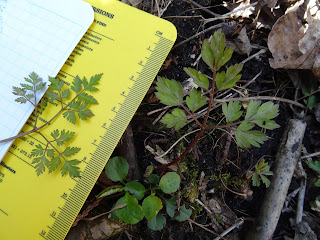On Sunday Alyssa and I took a trip down the Grand River, after Saturday's FBO trip to Arkona I was eager to spend another sunny day out and about.
Floodplains are starting to burst into bloom; an exciting time following a winter of twig ID!
This mammoth Snapping Turtle was basking on near the edge of the river. I would estimate it's shell measured about 60cm end to end with massive spines visible on it's tail.
Some seeps and sloughs are bright with Marsh Marigold (Caltha palustris), not yet at it's peak in these parts.
This was the first weekend I saw Red Trillium (Trillium erectum) in bloom. It's foul-smelling flowers attract carrion flies which help to pollinate the flowers.
White Trout-lily (Erythronium albidum) is generally an indicator of good floodplain habitat. In comparison to Yellow Trout-lily (E. americanum) I find it has broader, more teal (versus green), pale-looking leaves. On Saturday I learned that one way to differentiate the two (from pressed herbarium specimens which lack petal colour) is to examine the stamen lengths. My field notes are at work but I believe it was White has longer stamens than Yellow.
This has got to be the nicest Sharp-lobed Hepatica (Anemone acutiloba) I've ever seen. What a beauty, and right next to it were pink, mauve and white versions.
Cut-leaved Toothwort (Cardamine concatenata), which used to be of the genus Dentaria, presumably referring to the toothy leaves is a member of the mustard family. It is a host plant for West Virginia White butterflies and it's tubers were a food source for the Passenger Pigeon.
One highlight just off the river was an abundance of Twinleaf (Jeffersonia diphylla). After flowering, the seed pods form as an upright cup with a lid which eventually pops open releasing the spherical brown seeds.
Spicebush (Lindera benzoin) is hard to miss when in flower, most of the shrub is covered in these fluorescent. It can occur sporadically in a forest or swamp shrub layer, or can form dense thickets, usually in swamps which have amply saturated soils. I recall trying to navigate the Tanager Tract in West Elgin a few years back and begging for Spicebush mercy when I found myself deep in the middle of a never-ending thicket rife with mosquitoes and at the onset of thunderstorms.
Still a little early for the mauve-blue of Wild Blue Phlox (Phlox divaricata) (on the left).
I was very happy to find Harbinger of Spring (Erigenia bulbosa); it hadn't been documented in Brant County before. My search was challenged by an abundance of Wild Cicely (Myrrhis odorata), pictured to the left here for comparison. Harbinger has redder stems, smooth stems (not hairy like Cicely) and the leaves are less-finely divided.
After the trip the previous day where Tony had pointed out Carey's Sedge (Carex careyana), I put my search image to the test and came up with a sizable population.
I enjoy submitting my butterfly observations to ebutterfly and like to append photos when I can. I finally found an Eastern Comma willing to stay still long enough to get a shot.
Being introduced to Wavy-rayed Lampmussels by my co-worker a couple of weeks back I'm now paying more attention to the shells I find on riverbanks, here's another Wavy-rayed.
On the way home we stopped at a favourite Region-owned forest to check for basking turtles. The photo below are all Midland Painted, I'm not so sure about the one in the centre though, the shell looks a little domed.
And over on another log, a couple of domed shells which I can confirm to be Blanding's Turtles by the bright yellow chins.


















Patrick, great posting here. Your Hepatica photo helped me ID a flower I photographed last week in Windsor. I'm 90% sure its Hepatica. Keep up the great work! -DM
ReplyDeleteGlad you enjoy the blog. I've noticed alot of Hepatica were left with crumpled brown leaves after the last snow event, luckily the flowers seemed to have pulled through.
DeleteGreat time of year to see things like those!
ReplyDelete